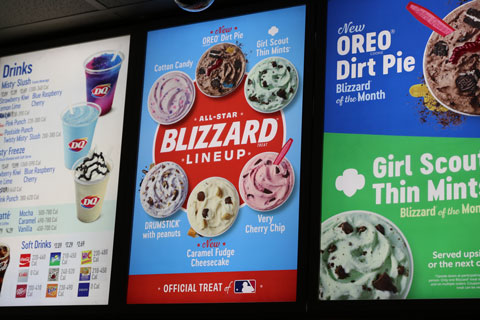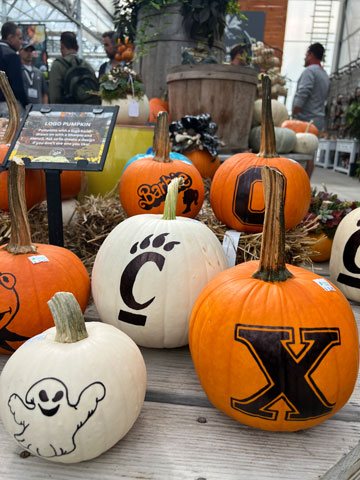10/1/2024
5 Types of Garden Center Merchandise
Sid Raisch

Communication is the biggest problem in any company, as is frequently noted by its associates or customers.
The root of communication problems in most cases begins with our language. I’m reminded of the famous story of the Tower of Babylon, where the builders were cursed to speak in different languages rendering them incapable of communicating with each other and stopping the project.
Pictured: Dairy Queen’s Blizzard products are an example of a Signature product—a product perceived by customers to be exclusive to that store, even if others have a competing option.
We have language issues with plant names, and as a result, our industry uses primarily botanical names as a common language so we can work together. Similar issues with other terms and phrases occur when we market our products, as well as in other areas of our businesses. My purpose is to align our thinking, terminology and understanding on the types of merchandise we sell so we can manage it better together.
Too often people in our companies see things the way they see them instead of the way they actually are. Merchandise is one of those areas. Within departments of garden centers we find Categories of Merchandise such as Annuals, Vegetables, Perennials, Shrubs and Trees, with these examples being the most common items sold in garden centers.
Parallel to these categories of merchandise you may not have noticed the Five Types of Merchandise. You’ve probably heard of the most commonly known type of merchandise, Never-Outs. Did you know there are four other types? Yes, there are four other types of merchandise sold in garden centers, but what are they?
 Pictured: Fertilizers as shown here are an example of products that should be in the Never-Out category.
Pictured: Fertilizers as shown here are an example of products that should be in the Never-Out category.
Never-Out Products
These are items you shouldn’t run out of because any customer should reasonably expect you to have them in stock. Never mind that you lose the incremental revenue and profit, but you also force your customer to go elsewhere to buy those Never-Out items, along with other things you probably did have in stock. Being out of Never-Out items causes your best customers to experience your competition, and if they’re on their toes, you may never see them again. Never-Out items are typically core to the business, high volume and create some vulnerability if your supply chain can’t keep you supplied in a timely manner so you don’t have to over-stock, tying up space and creating additional labor steps and expense.
Signature Products
These are items customers perceive to be yours and yours alone, whether they’re exclusively yours or not. The position you have in the marketplace helps secure Signature status. An example of this is the Dairy Queen Blizzard, which was so well launched it caught their competitors off guard and was taken for granted for a good while before they responded with competitive products. Other dairy bars, ice cream shops—even McDonald’s—aren’t able to sell a Blizzard, and their knock-off comparable product is perceived as less than the alternative even when it may be just as good or better in a blind taste test, no matter what price they choose to sell theirs at. By owning the Blizzard, Dairy Queen also owns a large part of the customer market for other items it sells. No, they don’t technically “own” a market, but the effect is similar because their customers don’t easily defect for a McFlurry. Blizzard and McFlurry are Never-Out items of their respective owners. McDonald’s also has a nasty habit of often being out of their McFlurry, a Never-Out.
Treasure-Hunt Products
If you like to go to certain stores just to see what they have, you’re on an expedition for Treasure Hunt merchandise. Costco is famous for their Treasure Hunt Experience, having perfected the process so every time you go into a Costco you’re going to find Treasure Hunt items in stock. However, you never know what those items will be, what price they’ll be or how long they’ll last. It’s generally accepted when you see a Treasure Hunt item at Costco you better buy it before it’s completely gone and out of stock ... forever.
 Pictured: Logo pumpkins like these are a Treasure Hunt item— customers better pick them up while they last.
Pictured: Logo pumpkins like these are a Treasure Hunt item— customers better pick them up while they last.
Treasure Hunt items aren’t Never-Out merchandise. The goal is to sell out of them. Treasure Hunt is a strategy using FOMO (Fear of Missing Out) to get customers to come early and often throughout the season for retailers who can practice it effectively. You don’t want to over-buy highly seasonal Treasure Hunt merchandise.
Lemonade Products
When life hands you too much merchandise it’s like having too many lemons. What are you going to do? Make lemonade, of course. If you haven’t had the experience of getting too much of something you eventually will. Whether your mistake or one a vendor makes, it’s common to be shipped more of something than you intended to buy every year or every few years. It’s part of life being a merchant. The obvious solution is to prevent this situation from occurring through careful ordering and checking everything over in the process of receiving it. If you prevent these errors you won’t discover new and different tasty lemonade. If the vendor made a mistake, ask for them to take back the portion of the order you can’t sell or to take it back.
Never-In Products
As the title suggests, Never-In merchandise shouldn’t have been bought in the first place. It can be any of the other types of merchandise. The three biggest mistakes in buying are:
• Buying too much of the right stuff
• Buying the wrong stuff
• Not buying enough of the right stuff
Be sure history doesn’t repeat itself by taking steps to ensure it’s never purchased again. (Code in POS:DNR—Do not reorder.)
A Delicate Balance
The buyer’s dilemma: Buying the right stuff, in the right amount, at the right time.
Before we wrap this up there’s one certainty in buying merchandise. I want everyone to be sure this concept is crystal clear to everybody in your company. The buyer makes the most mistakes in a retail business, or they should, because it isn’t like bowling where there’s a perfect game. There’s no perfect score. Either you have some of what you bought left over or you run short of the amount you could have sold.
Having too much left over is a sign of a problem. Having nothing left over is also a sign of a problem and it can be the bigger problem. The trouble is, the stuff you didn’t buy isn’t visible so you can’t actually see the bigger problem. The buyer isn’t the only person who’ll make mistakes, but they should be the only one to make a mistake more than once because if they’re doing their job they certainly should. The extent of the mistake is the tricky part to determine if we don’t make it go away before it shows up at the end of a season.
Come back next month for the second in this two-part series, with the theme “Simple steps to get rid of merchandise mistakes as intelligently as possible.” GP
Sid Raisch is a consultant to garden retailers. He’s developed the Advantage Development System to help garden centers grow the marketing, operations, pricing and merchandise management of their companies. Sid is affiliated with The Garden Center Group. He can be reached by text or cell at (937) 302-0423 or sid@horticulturaladvantage.com.